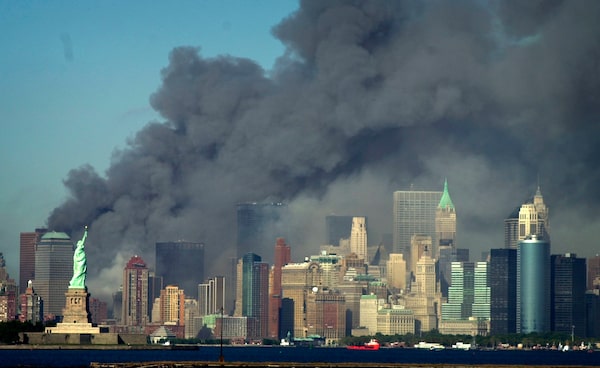
Thick smoke billows into the sky from the area behind the Statue of Liberty, lower left, where the World Trade Center was, on Sept. 11, 2001.Daniel Hulshizer/The Associated Press
Gus Carlson is a New York-based columnist for The Globe and Mail.
Seventy feet beneath the solemn pageantry of today’s 20th anniversary tributes at Ground Zero in lower Manhattan, a macabre controversy is stirring – the kind of bizarre and heart-wrenching stand-off that occurs when emotion and bureaucracy collide.
In a 2,500-square-foot bedrock-level storage area in the National September 11 Memorial and Museum lie the unidentified remains of more than 1,100 victims of the 2001 terrorist attacks on the World Trade Center. That’s about 40 per cent of the more than 2,700 people who died in and around the twin towers that day.
Many victims’ families say their loved ones deserve to be respectfully memorialized in public, not stowed away in a catacomb as part of the museum. The New York City Medical Examiner’s office, which is doing the painstakingly slow task of identification in the subterranean repository, says it will “do whatever it takes for as long as it takes” to identify as many victims as possible. But that is taking a long time: In the past 20 years, the remains of about 1,650 victims have been identified.
The process has slowed significantly in recent years. This week, Chief Medical Examiner Barbara Sampson announced that her office had identified two more victims – the first ones since 2019, a fact that underscored the challenge.
In the middle of the stalemate is Sally Regenhard, a longtime civic activist who lost her 28-year-old rookie firefighter son Christian in the attacks. Spurred by what she calls the “injustice” of his death, she has led the charge for victims’ families to have the unidentified remains moved from “file cabinets” in the basement of the museum to an appropriate resting place in the Memorial Plaza above ground.
“It’s an atrocity,” said Ms. Regenhard, who blames politics, bureaucratic insensitivity and bad judgment for the controversy. “It’s disrespectful and heartbreaking to these families who just want a resting place for their loved ones.”
She added: “As parents of 9/11, we have to accept the fact that our loved ones aren’t coming home. My son is gone. I know that because he never came home. But to have this on top of that is too much.”
To Ms. Regenhard and many families, the 20th anniversary of the attacks isn’t just about paying tribute to the memories of those lost. It’s about using the profile of the occasion to shine more light on the subject. And with renewed fears of terrorist attacks on the city after the U.S. military’s withdrawal from Afghanistan last month left behind a cache of sophisticated weapons now available to the Taliban, it is an opportunity to expose what they see as the unfinished business of the day.
That business is a hard one. A seemingly simple request for a public resting place for the 7,800 unidentified remains – ranging from microscopic samples to quarter-sized tissue fragments – has devolved into years of bickering and even litigation. Mayors, governors and even former president Barack Obama have been drawn into the fray.
The struggle peaked in 2014, when the Medical Examiner’s office announced it would move the remains to the repository at the museum site. The transfer confused and angered many, especially since the city gave families only a week’s advance notice.
After the move, a survey of victims’ families by New York lawyer Norman Siegel showed nearly 95 per cent of respondents disapproved of the underground storage repository and supported a public memorial site above ground. One idea for such a memorial, floated by Ms. Regenhard and others, seems thoroughly reasonable: The creation of something similar to the Tomb of the Unknown Soldier in Washington to hold the remains, placed at ground level within the existing memorial for all to see and appreciate. As remains are identified, they can be removed and returned to the victims’ families.
There is a lack of traction for her cause. Still, Ms. Regenhard remains hopeful. A 20-year anniversary is a meaningful benchmark that gets people’s attention. It’s also an opportunity to educate a new generation of New Yorkers on the issues, including building public support for the victims’ memorial cause that is her passion.
“If you lived through 9/11, you get it,” she says. “If you didn’t, it’s moments like this that teach people why this is so important and puts pressure on things to change.”
And, she agrees, in a city that has been whipsawed by almost two years of strife – from COVID-19, to violent demonstrations, to business closings to rising crime rates – Sept. 11, 2021, may be a day that unifies New Yorkers and, perhaps, provides a little healing.
Part of that healing may be a resolution to the memorial controversy – a confounding subplot to an already sad day of remembrance.
Keep your Opinions sharp and informed. Get the Opinion newsletter. Sign up today.